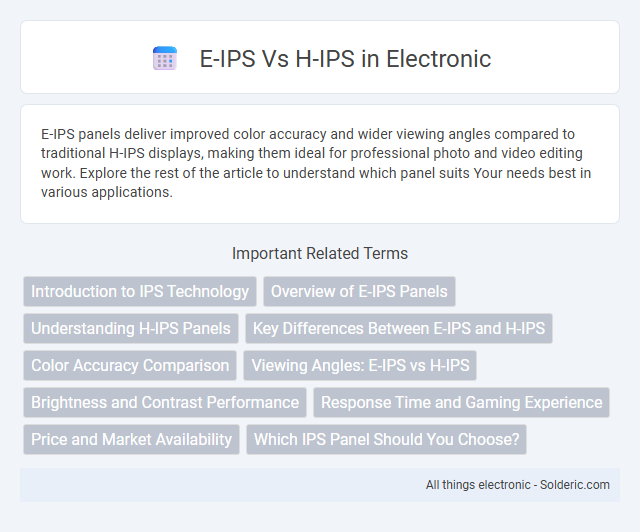E-IPS panels deliver improved color accuracy and wider viewing angles compared to traditional H-IPS displays, making them ideal for professional photo and video editing work. Explore the rest of the article to understand which panel suits Your needs best in various applications.
Comparison Table
| Feature | E-IPS | H-IPS |
|---|---|---|
| Technology Type | Enhanced In-Plane Switching | Horizontal In-Plane Switching |
| Viewing Angles | Wide viewing angles up to 178deg | Wider horizontal viewing angles, approx. 180deg |
| Response Time | Typically 4-6 ms | Improved response times, often 3-5 ms |
| Color Accuracy | High color accuracy, suitable for design | Enhanced color consistency at wide angles |
| Contrast Ratio | Standard IPS contrast ratio (1000:1) | Slightly improved contrast levels |
| Energy Efficiency | Moderate energy consumption | Optimized for lower power usage |
| Common Usage | Professional monitors, general usage | High-end displays, gaming and media |
Introduction to IPS Technology
IPS technology, including E-IPS (Enhanced In-Plane Switching) and H-IPS (Horizontal In-Plane Switching), revolutionizes display quality by improving color accuracy and viewing angles. E-IPS panels offer cost-effective solutions with vibrant colors and better energy efficiency, while H-IPS enhances image stability and brightness for professional-grade displays. Your choice between E-IPS and H-IPS depends on the balance you need between performance, budget, and application.
Overview of E-IPS Panels
E-IPS panels, or Enhanced In-Plane Switching panels, offer improved color accuracy and wider viewing angles compared to traditional TN panels, making them ideal for professional graphic design and photo editing. Compared to H-IPS (Horizontal In-Plane Switching) panels, E-IPS panels provide a balance of high image quality and cost efficiency, often featuring lower power consumption and better brightness uniformity. Key specifications of E-IPS include 8-bit color depth, sRGB coverage of over 99%, and response times typically around 5 ms, contributing to their popularity in mid-range monitors.
Understanding H-IPS Panels
H-IPS panels feature a horizontal alignment of liquid crystals, offering improved color accuracy and wider viewing angles compared to traditional E-IPS displays. These panels are ideal for professional use where precise color reproduction matters, such as graphic design and photo editing. Your experience with H-IPS technology benefits from consistent image quality and reduced color shift, even at extreme angles.
Key Differences Between E-IPS and H-IPS
E-IPS panels offer enhanced color accuracy and wider viewing angles ideal for professional photo and video editing, while H-IPS panels prioritize higher brightness and faster color response suited for gaming and multimedia. E-IPS typically delivers better color reproduction with 8-bit+FRC support, whereas H-IPS provides improved luminance and quicker gray-to-gray response times. Both utilize in-plane switching technology but target different performance needs through panel structure and driving methods.
Color Accuracy Comparison
E-IPS panels generally offer better color accuracy than H-IPS panels due to improved manufacturing techniques that enhance the consistency and range of color reproduction, making them ideal for professional photo and video editing. Your workflow benefits from E-IPS technology by delivering more precise and vibrant colors with wider color gamut support, often covering 98-100% of sRGB. While H-IPS panels provide good color fidelity, E-IPS outperforms with reduced color shift and better grayscale performance, ensuring more accurate and reliable image representation.
Viewing Angles: E-IPS vs H-IPS
E-IPS panels offer wider viewing angles with minimal color shift, typically up to 178 degrees both horizontally and vertically, ensuring consistent image quality from various positions. H-IPS technology, an advancement over E-IPS, enhances color accuracy and maintains stable viewing angles close to 178 degrees, especially improving off-axis color uniformity. Compared to E-IPS, H-IPS delivers superior visual performance in professional applications requiring precise color consistency across broad viewing angles.
Brightness and Contrast Performance
E-IPS panels typically offer lower brightness levels around 250-300 nits, whereas H-IPS panels can achieve higher brightness up to 350-400 nits, enhancing visibility in well-lit environments. Contrast ratio in E-IPS displays usually ranges from 800:1 to 1000:1, while H-IPS panels provide improved contrast performance around 1000:1 to 1200:1, resulting in deeper blacks and more vibrant colors. Enhanced brightness and contrast capabilities of H-IPS technology make it suitable for professional photo and video editing where accurate color representation is critical.
Response Time and Gaming Experience
E-IPS panels typically offer faster response times compared to H-IPS, reducing motion blur and ghosting for smoother gameplay. This lower latency enhances your gaming experience by delivering sharper visuals during fast-paced action. Gamers seeking fluid performance often prefer E-IPS displays for their optimized speed and clarity.
Price and Market Availability
E-IPS panels generally offer a more affordable price point compared to H-IPS panels, making them popular in budget-friendly monitors. H-IPS displays, known for superior color accuracy and wider viewing angles, tend to be priced higher and are targeted at professional markets like graphic design and photography. Market availability of E-IPS panels is broader due to their lower cost, whereas H-IPS panels are less common and typically found in high-end or specialized displays.
Which IPS Panel Should You Choose?
E-IPS (Enhanced IPS) panels offer better color accuracy and energy efficiency compared to H-IPS (Horizontal IPS) panels, making them ideal for professional photo and video editing. H-IPS panels provide wider viewing angles and higher contrast ratios, suited for immersive gaming and multimedia consumption. Choosing between E-IPS and H-IPS depends on your priority: color precision and power savings point to E-IPS, while superior viewing experience and contrast favor H-IPS.
E-IPS vs H-IPS Infographic

 solderic.com
solderic.com